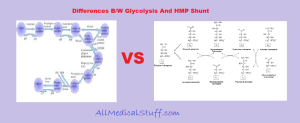Glycolysis (also called Embden Meyerhoff pathway) and HMP shunt (also called pentose phosphate pathway, phosphogluconate pathway or direct pathway) both are glucose breakdown pathways. The difference is that glycolysis is the breakdown of glucose up to pyruvate or lactate. While HMP shunt is the breakdown of glucose to yield different metabolic intermediates. The end products of HMP stunt are 2 molecules of glucose 6 phosphate and 3 molecules of 3 phosphoglyceraldehyde.
Both pathways has the break down of glucose. But the end products are different. Not only this, there are several more differences between glycolysis and hmp shunt that are described below:
Glycolysis VS HMP shunt-Differences and Similarities:
Here are the key differences between the two pathways:
1. Mechanism:
Glycolysis is the breakdown of glucose up to pyruvate (in aerobic glycolysis) or lactate (in anaerobic conditions). While HMP shunt is also a breakdown of glucose but it yields different metabolic products.
2. Starting compound:
Glycolysis starts from glucose while HMP shunt starts from glucose 6 phosphate.
3. Sub types:
Glycolysis can aerobic (in the presence of oxygen) or anaerobic (in the absence of oxygen). While pentose phosphate pathway has no sub types.
4. ATP production and utilization:
In glycolysis 2 ATP’s are used to provide phosphate to glucose and fructose 6 phosphate. And 10 ATP’s are produced i.e 4 directly (substrate level phosphorylation) and 6 from NADH2.
While in case of phosphogluconate pathway no NO ATP’s are utilized or produced.
5. NADH2 and NADPH2 productions:
2 NADH2 are produced in glycolysis while NADPH2 is produced in direct pathway i.e HMP shunt.
6. Location in body:
Glysolysis occurs in all parts of the body. While hmp shunts mostly takes place in that parts of the body where lipid and steroid synthesis takes place. Such as lactating mammary glands, RBC’s, adipose tissue, thyroid, liver, adrenal cortex, testes and ovaries etc.
7. CO2 Production:
Carbon dioxide is not produced in glycolysis. While CO2 production is the specific characterisic of pentose phosphate pathway. It is produced in 6 phosphogluconate is converted to ribulose 5 phosphate in the presence of ” 6 phosphogluconate dehydrogenase” enzyme.
8.End Product:
End product of glycolysis is pyruvate or lactate. While that of direct pathway are 2 molecules of glucose 6 phosphate and 3 molecules of 3 phosphoglyceraldehyde.
- If the end product is pyruvate in glycolysis, it depends on TCA cycle/ kreb’s cycle for its complete oxidation.
- The end products of HMP shunt are not dependent on TCA cycle.
9. Oxidation in First Step:
In glycolysis, oxidation doesn’t occur in the first step while in direct pathway, oxidation do occur in the first step.
10. No of Glucose molecules required:
One molecule of glucose is required for glycolysis. While three molecules of glucose are required for complete process of HMP shunt.
11. Pentose production:
No pentoses are produced in glycolysis while they are produced in direct pathway.
There are many other differences as well but the ones mentioned above are the main differences between glycolysis and HMP shunt. And they are enough for a medical student to learn about the differences, similarities and importance of these pathways.

wow. nice one admin,, medical biochemistry is somewhat ambiguous to some people
thanks…do visit all medical stuff again for more medical related stuff…
Sir how i want to remember each enzyme used in cylce? Theres so many
you would need to memorize that. try creating some mnemonic for yourself or search one via google…
Thanks.. and now i have an answer for my assignment… Longlive for this site to help more med students
Good job admin ..
now I have answers to what I have been trying to figure out …..
i am glad to know that my post solved your problem. keep visiting.
Why 35 atp in hmp pathway, whereas 38 atp in emp pathway?
the answer is given in heading no 4.
Why & how three molecules of glucose are required for complete process of HMP shunt.?